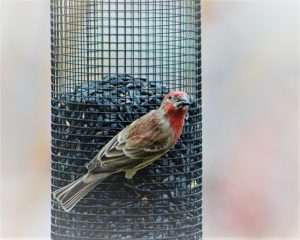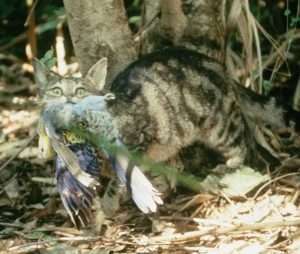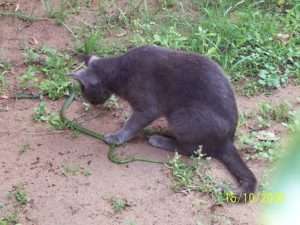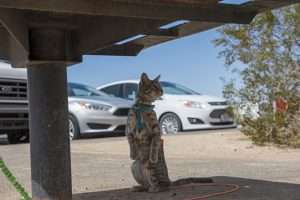While all the cats (Felis catus) I’ve had as an adult have been strictly indoors, when I was a kid we had an outdoor cat and our neighbors had a few, too. I remember the dramas among the various feline wanderers as they staked out their territories in yards and fields. And one year, while I was at a summer camp, our cat wandered off yet again–and never came home. But this was after five years of her bringing home various dead wildlife, even though she was perfectly well-fed. So began my introduction to the conflicts of outdoor cats and birds.
Disappearing Birds
 Over the years I’ve worked hard to educate myself on various ecological issues, to include those that affect the everyday wildlife around us and their habitats that are nestled in and among our own homes. Some of what I’ve found has been incredibly unsettling, like the fact that there are three billion fewer birds in North America than when I was born. Given that there are only about ten billion birds total in North America, the loss of three billion is quite significant. That’s one out of every four birds gone in a few decades.
Over the years I’ve worked hard to educate myself on various ecological issues, to include those that affect the everyday wildlife around us and their habitats that are nestled in and among our own homes. Some of what I’ve found has been incredibly unsettling, like the fact that there are three billion fewer birds in North America than when I was born. Given that there are only about ten billion birds total in North America, the loss of three billion is quite significant. That’s one out of every four birds gone in a few decades.
And what we had forty to fifty years ago is much lower than the number of birds before European colonized this land. So it’s not just that “three billion more” is the target we should be aiming for; to stop there is to fall prey to environmental generational amnesia. Instead, this most recent drop is just the latest milestone in a long, precipitous series of losses that has resulted in the extinction of several North American species, and the endangerment of dozens more.
What has caused the loss of so many birds in the past couple of centuries? Habitat loss is the single biggest cause of species extinction and endangerment across the board, not just birds, but other animals, plants, and other life forms. Every acre of land that is turned to agriculture, housing, or other human development is one less acre that will support a diverse variety of species, and when a given species runs out of suitable habitat–it disappears forever.
Outdoor Cats and Birds

If you take away habitat loss, the single biggest cause of wild bird mortality is outdoor cats. Studies estimate that cats slaughter 2.4 billion–that’s with a B, not an M–birds every single year just in the United States. That’s more than all the other human-caused causes of bird mortality combined, including window strikes, collisions with power lines, etc. And it’s not counting the billions more killed by cats everywhere else in the world each year. While smaller birds like songbirds are the most likely targets, larger birds like jays, crows, and young waterfowl aren’t safe, either.
Cats won’t necessarily bring home every animal they kill, either. Your indoor-outdoor cat that you’ve never seen with a dead bird may still be out there hunting numerous wildlife for fun. And they’re not just targeting non-native species; two out of every three birds killed by a cat in North America is a native species.
Fledglings are particularly vulnerable to cat predation. One study showed that 79% of baby gray catbirds (Dumatella carolinensis) in a Washington suburb were killed by cats. If four out of every five birds in a nesting year fall prey to cats, and other end up dying due to natural causes like native predators, diseases, starvation, etc., that spells a dim future for the birds in the area. And this isn’t even taking into account the fact that the very presence of cats causes birds to be less likely to successfully breed in the first place.
Birds (and other wildlife) that survive the initial attack are liable to die even if taken immediately to a wildlife rehabilitation center. The injuries–to include internal ones that may not be visible–are often too severe for the animal to recover from even with the best veterinary care. The bacteria in cat saliva is lethal to birds whether their skin is punctured or not; if the bird ingests the bacteria while preening its feathers after the attack, it can become very sick and die.
While it is true that three out of every four birds killed is the prey of a feral cat rather than an owned one, the very existence of domestic cats is our doing. We domesticated them, and we took them all around the world with us. They are, to this day, our responsibility.
Other Native Wildlife

The mortality numbers for other wildlife such as small mammals, reptiles, and amphibians, are even worse. In the United States, cats kill anywhere from 6 to over 22 billion non-bird wild animals every year. While some may be non-native mice, native species of mouse, vole, rabbit, and shrew are also vulnerable to predation. Cats may also slaughter native snakes, frogs, lizards, and even catch fish out of waterways.
And again, that’s just the impact in one country. Worldwide, cats have caused the complete and irreversible extinction of 63 species of wild animal. That’s over five dozen animal species that we will never get to interact with again thanks to outdoor cats. And the threat continues; 8% of all endangered species worldwide are being driven toward extinction by cats.
“But what about rats and mice? Cats have a job, after all!” While mice may be part of a cat’s prey now and then, rats are another thing entirely. Some urban programs involve intentionally releasing feral cats to control the rat populations in cities. Unfortunately, they don’t work as well as one might hope; the rats are too big for most cats to take on, and actual predation by cats is rare. In one study in New York City, an introduced colony of feral cats killed a total of two rats over a period of 79 days. Suffice it to say, the negative impact of cats on native wildlife severely negates any benefit they offer in controlling rats.
What Do We Do?
The solution is both simple and at the same time not at all easy to implement. In short: keep all cats indoors, and spay and neuter any cats not in a dedicated breeding program, to include fixing all cats currently in feral colonies. Okay, yes, it is easier said than done, at least on a large scale. But it’s a goal to work toward if we want to protect wildlife–and it’s a simple choice to start with your own cats.
 If pet cats are kept inside, then they won’t be casually hunting wildlife they don’t need to survive. Cats can be leash-trained with not much more effort and patience than dogs. If you have the space, time, and other resources, a catio is a great way for cats to get some time outside while keeping wildlife safe from them–and the cats safe from larger wildlife that may see them as a convenient meal. If your cat is unhappy indoors, you just need to increase their enrichment with more toys, hiding places, and other things to keep them engaged. Don’t give into their crying at the door, or you’ll undo any progress you’ve made.
If pet cats are kept inside, then they won’t be casually hunting wildlife they don’t need to survive. Cats can be leash-trained with not much more effort and patience than dogs. If you have the space, time, and other resources, a catio is a great way for cats to get some time outside while keeping wildlife safe from them–and the cats safe from larger wildlife that may see them as a convenient meal. If your cat is unhappy indoors, you just need to increase their enrichment with more toys, hiding places, and other things to keep them engaged. Don’t give into their crying at the door, or you’ll undo any progress you’ve made.
Consistent sterilization of pet cats means that “oops” litters don’t occur, and shelters don’t get absolutely slammed with kittens (along with the various stray and surrendered adult cats needing new homes.) And although trap-neuter-release (TNR) programs do allow feral cats to go back outside where they will continue killing wildlife for the rest of their lives, if 100% sterilization is successful then the population will crash within a few years.
Some people argue for the complete eradication of feral cats, and in some situations on islands and other wild habitats this has led to the rebound of rare wildlife. This, unsurprisingly, is an incredibly controversial issue, as people who wouldn’t bat an eye at the eradication of feral rats will cry foul at the extermination of animals that remind them of their own beloved pet cats. The existence of TNR programs is an attempt at compromise that does allow the cats to live, but at the continued cost of local wildlife. The debate about this continues to be incredibly contentious.
There are also people who are outright apologists for the predation done by both owned and feral outdoor cats, even going so far as to proudly share pictures of their cats’ kills on social media. Arguments like “It’s natural for them to want to hunt!” and “We’ve always had outdoor cats!” are common from such individuals. To them, their cats’ ability to roam outside is a much higher priority than the lives of native wildlife.
 Yet the more understanding one has of ecology and how all the various species in an ecosystem rely on each other, the more important it becomes to protect those wild species. Every bird killed by an outdoor cat is one less bird that’s able to contribute to the local gene pool, and all those losses add up. Imagine if all those 2.4 billion birds every year were allowed to continue living their lives without feline interference. Sure, some would end up dying due to other causes, but many would survive to raise at least one more generation of young to help keep the species going. We could easily see the total bird population rise by three billion–or more.
Yet the more understanding one has of ecology and how all the various species in an ecosystem rely on each other, the more important it becomes to protect those wild species. Every bird killed by an outdoor cat is one less bird that’s able to contribute to the local gene pool, and all those losses add up. Imagine if all those 2.4 billion birds every year were allowed to continue living their lives without feline interference. Sure, some would end up dying due to other causes, but many would survive to raise at least one more generation of young to help keep the species going. We could easily see the total bird population rise by three billion–or more.
So if, like me, you think cats are wonderful companions, and you also love your local wildlife, keep all of them safe. Let your (spayed and neutered) cats enjoy longer lives indoors (12-18 years versus 3 years for outdoor cats), let your local wildlife thrive without the additional pressure of a non-native predator, and let yourself enjoy the presence of all these amazing, beautiful animals, both domestic and wild. It’s a win-win for all involved.
